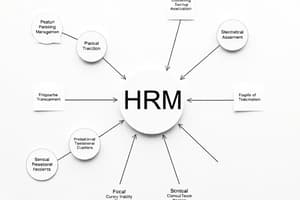Podcast
Questions and Answers
What is another name for the Michigan Model in HRM?
What is another name for the Michigan Model in HRM?
- Cultural Model
- Soft Model
- Strategic Model
- Matching Model (correct)
Which of the following best describes the focus of the Michigan Model?
Which of the following best describes the focus of the Michigan Model?
- Comprehensive stakeholder engagement
- Alignment of HR strategies with overall business strategies (correct)
- Employee welfare and soft HRM practices
- Long-term employee development
What is a key characteristic of the Harvard Model?
What is a key characteristic of the Harvard Model?
- Recognition of multiple stakeholders (correct)
- Strict autocratic leadership
- Focus on cost-cutting measures
- Short-term business strategies
Which principle is emphasized in the human resource cycle according to the Michigan Model?
Which principle is emphasized in the human resource cycle according to the Michigan Model?
The Michigan Model is characterized by which type of HRM?
The Michigan Model is characterized by which type of HRM?
When was the Michigan Model developed?
When was the Michigan Model developed?
What does the Harvard Model emphasize over the Michigan Model?
What does the Harvard Model emphasize over the Michigan Model?
What leadership style is commonly associated with the Michigan Model?
What leadership style is commonly associated with the Michigan Model?
What defines a system in the context of Human Resources Management?
What defines a system in the context of Human Resources Management?
What is the premise of General Systems Theory as proposed by Ludwig von Bertalanffy?
What is the premise of General Systems Theory as proposed by Ludwig von Bertalanffy?
Which of the following best illustrates the principle 'The whole is greater than the sum of its parts'?
Which of the following best illustrates the principle 'The whole is greater than the sum of its parts'?
How does the sociotechnical system concept define an organization?
How does the sociotechnical system concept define an organization?
Why is HRM considered a central subsystem in an enterprise?
Why is HRM considered a central subsystem in an enterprise?
What does the interaction of subsystems in a system imply?
What does the interaction of subsystems in a system imply?
Which of the following describes a model in the context of HRM?
Which of the following describes a model in the context of HRM?
What is a key characteristic of outputs in a system?
What is a key characteristic of outputs in a system?
Flashcards
System
System
A set of interconnected parts working towards a common goal.
General Systems Theory (GST)
General Systems Theory (GST)
A theory that complex systems share common organizing principles that can be modeled.
Open System (Organization)
Open System (Organization)
An organization that interacts with its environment, taking inputs and producing outputs.
Sociotechnical System
Sociotechnical System
Signup and view all the flashcards
HRM (Human Resources Management)
HRM (Human Resources Management)
Signup and view all the flashcards
Model
Model
Signup and view all the flashcards
'The whole is greater than the sum of its parts'
'The whole is greater than the sum of its parts'
Signup and view all the flashcards
Inputs, Processes, Outputs
Inputs, Processes, Outputs
Signup and view all the flashcards
Michigan Model of HRM
Michigan Model of HRM
Signup and view all the flashcards
Harvard Model of HRM
Harvard Model of HRM
Signup and view all the flashcards
Hard HRM
Hard HRM
Signup and view all the flashcards
Soft HRM
Soft HRM
Signup and view all the flashcards
Human Resource Cycle (Michigan Model)
Human Resource Cycle (Michigan Model)
Signup and view all the flashcards
Strategic HRM
Strategic HRM
Signup and view all the flashcards
Matching Model
Matching Model
Signup and view all the flashcards
Stakeholders
Stakeholders
Signup and view all the flashcards
Study Notes
Human Resources Management Techniques I
- Professor: Zulema Nacimiento, PhD.
- Institution: University of Huelva
- Unit: 0-2
Systemic Approach and HRM Models
- Unit: 0-2
- Topic: The Systemic Approach and HRM Models
What is a System?
- A system is a group of interconnected parts that work together toward a common goal.
- A system can also be composed of subsystems, which are smaller, integrated parts.
- Systems have inputs, processes, and outputs that work together to achieve the overall goal.
General Systems Theory (GST or ST)
- Developed by Ludwig von Bertalanffy in 1968
- GST's premise: Complex systems share organizing principles that can be mathematically modeled.
- Used to explain all systems in all scientific fields
- Became a paradigm - a framework for understanding systems.
- Key Idea: "The whole is greater than the sum of its parts." (e.g., baking a cake – ingredients individually are not a cake)
The Organization as an Open System
- Inputs: Raw Materials, Human Resources, Capital, Technology, Information
- Transformation Process: Employees' Work Activities, Management Activities, Technology & Operations Methods.
- Outputs: Products & Services, Financial Results, Information, Human Results
- Feedback loop: Continuous cycle; informs and readjusts the process using the output information.
The Organization as a Sociotechnical System
- Organizations are made up of two interacting systems: a technology system (tasks, equipment, working arrangements) and a social system (employee interpersonal relationships)
- These two systems are constantly interacting and influencing each other.
HRM as a Central Subsystem
- HRM (Human Resource Management) is a crucial subsystem within overall organizational functions.
- Interactions between HRM and other subsystems (e.g., Product, Marketing, Technical) are vital.
Models of HRM
- Models are prototypes or abstractions representing reality in HRM.
HRM Models: The Michigan Model
-
Also known as the Matching Model or Best-Fit Model
-
Developed by Fornbun, Tichy & Devanna in 1984 at the Michigan Business School.
-
Focuses on hard HRM and aligning HR strategies with overall business strategies.
-
Matches employee characteristics to business needs.
-
Emphasizes the human resource cycle: Recruitment & Selection, Performance & Monitoring, Rewards, Development & Training.
-
Aligns HR to business strategy (mission, structure).
-
Focus is on cost reduction and efficiency (hard HRM).
-
Short-term focus and autocratic leadership.
-
Key Principles:
- Tight Fit: HR strategies need to align with the overall organizational strategies.
-
Importance of Business Strategy: hard HRM
HRM Model: The Human Resource Cycle (Michigan Model)
- Cycle of activities from recruitment to development, ongoing performance monitoring and appraisal.
- Recruitment and selection
- Performance
- Reward/Compensation
- Appraisals/Performance Review
- Development training and feedback loops.
The Michigan Model: Inputs, Transformation, and Outputs
- Inputs (e.g., hiring applicants): organization strategies, political and economic factors, human resources
- Transformation (e.g., onboarding and orientation): Matching employee characteristics to business needs and strategic objectives.
- Outputs (e.g., employee productivity gains): Matching individuals to best suited employment roles/objectives.
HRM Model: Michigan Model (continued)
- Advantages: Cost-effective, faster decision-making by senior management only.
- Disadvantages: Demotivating for employees, ineffective recruitment practices, high turnover, ignores stakeholder interests.
HRM Models: The Harvard Model
- Also known as "Soft HRM"
- Proposed by Beer in 1984 at Harvard University.
- Focuses on the human aspect of HRM, recognizing multiple stakeholder interests.
- The organization and HR's role are integral/central to the success and efficiency.
- HRM is a set of policy choices influencing work systems and employee well-being.
- Long-term focus and empowering employees.
- Emphasizes: Employee participation, motivation, empowerment, high productivity, collaboration and communication, and equal opportunity.
Harvard Model: Advantages and Disadvantages
- Advantages: Employee participation, better employee commitment, high productivity, positive employee-employer relationships, easier communication and teamwork.
- Disadvantages: High cost, possible wage increases, longer decision-making processes.
Michigan and Harvard Models: Aims
- Effective utilization of HR to achieve organizational objectives. This is done in an aligned, integrated manner with existing business strategy.
Studying That Suits You
Use AI to generate personalized quizzes and flashcards to suit your learning preferences.




